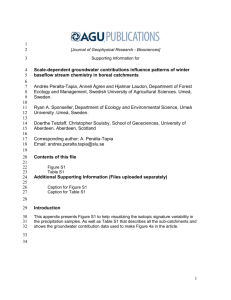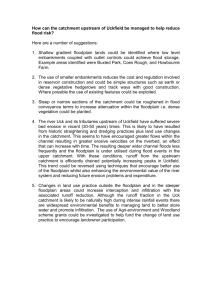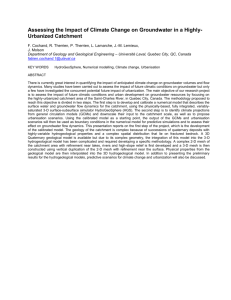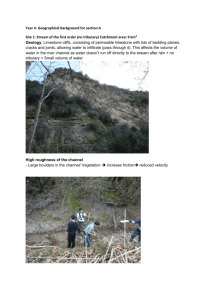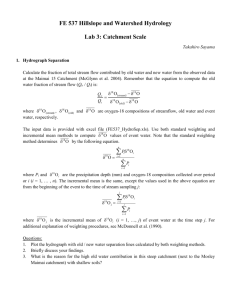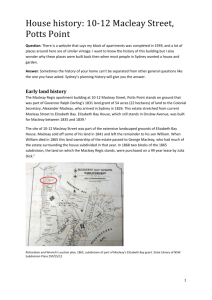Paul Ashley on Arsenic - Save Our Macleay River
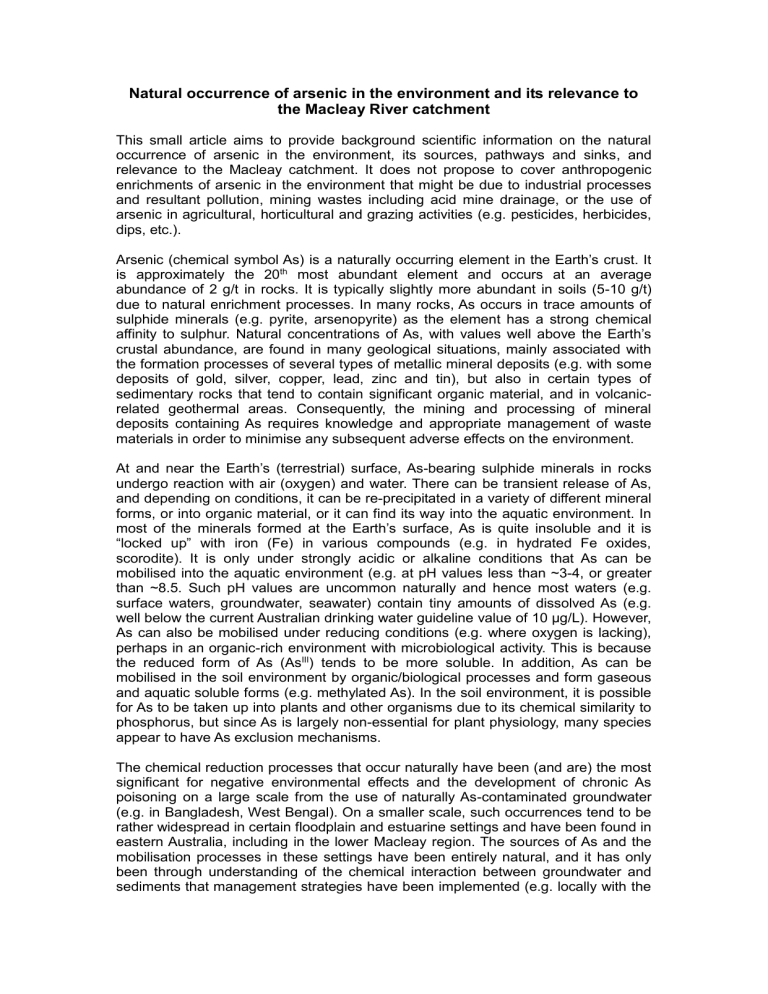
Natural occurrence of arsenic in the environment and its relevance to the Macleay River catchment
This small article aims to provide background scientific information on the natural occurrence of arsenic in the environment, its sources, pathways and sinks, and relevance to the Macleay catchment. It does not propose to cover anthropogenic enrichments of arsenic in the environment that might be due to industrial processes and resultant pollution, mining wastes including acid mine drainage, or the use of arsenic in agricultural, horticultural and grazing activities (e.g. pesticides, herbicides, dips, etc.).
Arsenic (chemical symbol As) is a naturally occurring element in the Earth’s crust. It is approximately the 20 th most abundant element and occurs at an average abundance of 2 g/t in rocks. It is typically slightly more abundant in soils (5-10 g/t) due to natural enrichment processes. In many rocks, As occurs in trace amounts of sulphide minerals (e.g. pyrite, arsenopyrite) as the element has a strong chemical affinity to sulphur. Natural concentrations of As, with values well above the Earth’s crustal abundance, are found in many geological situations, mainly associated with the formation processes of several types of metallic mineral deposits (e.g. with some deposits of gold, silver, copper, lead, zinc and tin), but also in certain types of sedimentary rocks that tend to contain significant organic material, and in volcanicrelated geothermal areas. Consequently, the mining and processing of mineral deposits containing As requires knowledge and appropriate management of waste materials in order to minimise any subsequent adverse effects on the environment.
At and near the Earth’s (terrestrial) surface, As-bearing sulphide minerals in rocks undergo reaction with air (oxygen) and water. There can be transient release of As, and depending on conditions, it can be re-precipitated in a variety of different mineral forms, or into organic material, or it can find its way into the aquatic environment. In most of the minerals formed at the Earth’s surface, As is quite insoluble and it is
“locked up” with iron (Fe) in various compounds (e.g. in hydrated Fe oxides, scorodite). It is only under strongly acidic or alkaline conditions that As can be mobilised into the aquatic environment (e.g. at pH values less than ~3-4, or greater than ~8.5. Such pH values are uncommon naturally and hence most waters (e.g. surface waters, groundwater, seawater) contain tiny amounts of dissolved As (e.g. well below the current Australian dr inking water guideline value of 10 µg/L). However,
As can also be mobilised under reducing conditions (e.g. where oxygen is lacking), perhaps in an organic-rich environment with microbiological activity. This is because the reduced form of As (As III ) tends to be more soluble. In addition, As can be mobilised in the soil environment by organic/biological processes and form gaseous and aquatic soluble forms (e.g. methylated As). In the soil environment, it is possible for As to be taken up into plants and other organisms due to its chemical similarity to phosphorus, but since As is largely non-essential for plant physiology, many species appear to have As exclusion mechanisms.
The chemical reduction processes that occur naturally have been (and are) the most significant for negative environmental effects and the development of chronic As poisoning on a large scale from the use of naturally As-contaminated groundwater
(e.g. in Bangladesh, West Bengal). On a smaller scale, such occurrences tend to be rather widespread in certain floodplain and estuarine settings and have been found in eastern Australia, including in the lower Macleay region. The sources of As and the mobilisation processes in these settings have been entirely natural, and it has only been through understanding of the chemical interaction between groundwater and sediments that management strategies have been implemented (e.g. locally with the
Stuarts Point water supply).
In the Macleay River catchment, As concentrations in rocks and resultant soils are commonly slightly above Earth’s crust abundance levels, due to particular geological processes that have acted in the New England region. There are several locations in the catchment that have enhanced As values due to the processes that have given rise to the numerous and diverse types of mineral deposits, including some of the well-known locations such as Hillgrove, Enmore-Melrose, Rockvale and Halls Peak.
There are also diffuse zones of rock that have enhanced As values that are not known to be directly related to mineral deposits and these have contributed to As values in soil and stream sediment. The siting of As in rocks forming the substrate of the catchment is mostly in sulphide minerals as mentioned above, but due to processes of weathering and transportation, As in soil and stream sediments is transformed into new minerals and non-crystalline substances (e.g. mostly hydrated
Fe oxide) that are commonly stable and insoluble at normally prevailing conditions of pH (acidity-alkalinity) and redox (oxidation and reduction, related to the availability of oxygen) and hence no significant As would be expected to be present in stream water.
Disturbance of the land surface, e.g. by bulldozing, or drilling into the ground, might cause local increased access of As-bearing rock and soil to rain (or groundwater), but it does not necessarily mean increased As in stream water. As is commonly strongly chemically bound with iron (Fe) oxide phases in soils and stream sediments and is effectively insoluble. However, solubility increases under acid conditions (e.g. pH < 3-
4) and that is why management of acid sulphate soils on the Macleay floodplain is important. There is also increased solubility of As under alkaline conditions (pH > 8) and under reducing conditions (less oxygen, more organic material). That is also why management of sulphide-bearing material (e.g. in mine tailings dams) is critical, as such impoundments can be acid-producing, or be alkaline. If, for example, there was ground disturbance of As-bearing rock or soil, if the pH of the stream water was maintained in the typical range 6-8 as found in the Macleay catchment, then As is effectively insoluble. However, if there were abundant sulphide minerals present, this situation could lead to acidity being produced on exposure to rain and air and As solubility could be increased. This effect could be rapidly and effectively negated by neutralisation (e.g. with carbonate) and by dilution. The normally strongly oxidising condition of flowing water in Macleay catchment streams again would tend to suppress any As solubility. The research work at UNE over the period 1999 to the present has found little indication of uptake of As into riparian plants and invertebrate aquatic organisms (i.e. bio-accumulation), and generally, the amount of As in surface
(stream) waters does not exceed the Australian drinking water guideline value.
Current metal mining and mineral exploration activities in the Macleay catchment are strongly regulated by statutory authorities and egr ess of “newly liberated” (and hence anthropogenic) As into streams is extremely limited. The legacy situation that has been inherited from unregulated mine waste disposal into the upper Macleay pre-
1970’s has not led to widespread or chronic contamination of stream water by As and there is no evidence to suggest that current or future activities would change the situation, given the increase of environmental awareness, regulations, monitoring and the tiny scale of the area of activities compared to the catchment as a whole. A more significant concern is the use of untested groundwater from the Macleay floodplain, e.g. for domestic and stock watering purposes, because of the
Bangladesh As-poisoning analogy. It is possible that there are aquifers in the floodplain region that have reduced waters (low-oxygen) in which As solubility is increased. The sediments hosting the aquifers are not contaminated by mine waste and have low, natural As contents, similar to the situation in Bangladesh. At least
locally, this situation was recognised many years ago and a water treatment plant was installed at Stuarts Point. A similar situation could exist at Bellbrook, where slight
As anomalies in water supplies could be due to the fact that water was drawn from the stream bed gravel and not from flowing water.
Paul Ashley
Earth Sciences
University of New England
11-4-15

